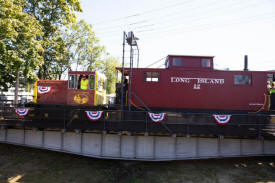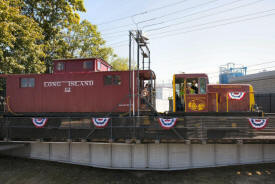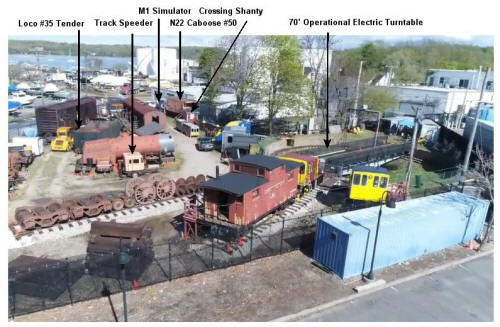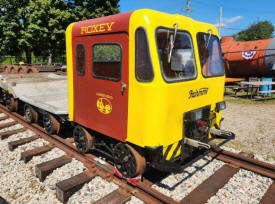|
OYSTER BAY RAILROAD MUSEUM |
||
|
|
|
|
|
OYSTER BAY RAILROAD MUSEUM |
||
|
|
|
|
 Oyster Bay Railroad Museum building plaque street-side wall - 6/01/2024 |
 |
 On June 1, 2024, Javier Lopez installed the "National Register of Historic Places" plaque onto the street-side wall of the Oyster Bay Railroad Museum building. |
 Model T Ford Club of Long Island visited OBRM on 10/25/2025 Photo/Archive: OBRM
|
|
|
|||
| EQUIPMENT ROSTER | |||
 OBRM Yard aerial 4/23/2023 - Photo/Archive: Brandon Kulik |
 LIRR GE GS-1 #397 |
 LIRR GS-1 Dinky #26 to be named the “Theodore Roosevelt” |
|
 GS-1 Dinky #26 The pneumatic controls are whistle, bell, front and rear sanders and windshield wipers. |
|||
|
Dinky #26 Cab
Controls: The throttle lever is directly connected via cable to the
engine governor. It has a return spring and no notches.
The direction lever simply selects forward, neutral, or reverse.
This particular locomotive is only equipped with an independent brake.
There are no train brake or hoses as it was only meant to move
non-functional locomotives throughout the shop. The primary gauges
are oil pressure, water temperature, air pressure in the main reservoir
and brake cylinder, battery voltage, current draw by the traction motor,
and an engine hour gauge. John Petsche |
|||
|
These were two of three four-wheeled, chain driven, GE 25T 25 ton diesel locomotives that toiled away in the backshops of the Long Island Railroad from 1958 through the early 2000s. Used for shuttling locomotives and coaches to and from the shops, these engines served the railroad well, working in virtual anonymity. Preferred by the employees who used them, they were affectionately known as Dinky's. Dinky #26 has been restored and is open for visiting. More information: GE GS-1 25 ton diesel locomotives |
|||
|
|
|||
 Caboose #12 Class N52A 6/06/2010 Photo/Archive: Richard Glueck |
 Caboose #12 Class N52A restored interior by OBRM. |
 Oyster Bay turntable mid-1960's Photo/Archive: Richard Glueck |
 Oyster Bay 70' turntable installed in 1904. February 1992 photo prior to OBRM renovation Photos/Archive: Steve Torborg |
|
In the early 1920's, the LIRR ordered a fleet of Class N52A wood bodied, steel-framed cabin cars to bring up the rear of its freight trains. Built by American Car & Foundry, these cars served well for many years. Most were not retired until the late 1950's. At that point, a few were sold to private individuals and moved off of Long Island. One of these cars, #12 built in 1927 for a cost of $17,880, found its way to the Shore Line Trolley Museum in Connecticut, where it was used for sleeping quarters by their volunteers. With alternate sleeping accommodations later available in the area, the Trolley Museum had little need for a caboose in their collection, at which time they offered to sell the car to the Railroad Museum for return to Long Island, where its historic significance would be realized. In 2002, after years of fundraising and hard work by our volunteers, #12 returned to Long Island. This is open for viewing. |
 Returned to operational status 2021, here's more about the turntable: Oyster Bay Turntable |
 OBRM 70' electric turntable 2/12/2023 |
|
|
Caboose #12 is pulled onto the turntable, June 3, 2023, the first time being locomotive hauled on Long Island in some 70 years! When restoration work is complete later this summer, our visitors will be able to take short rides in this historic 96 year old caboose, and have a spin on our 100+ year old turntable, ONLY at the Oyster Bay Railroad Museum! |
 |
 16 volunteers on the turntable 4/29/2023 |
|
|
Turntable video in action
June 4, 2025! Archive: Dave Morrison - OBRM |
|||
 |
 |
 |
 |
| The 26th U.S. president Theodore Roosevelt, who served from 1901 to 1909. #26 GS-1 Dinky now renamed the "Col. Roosevelt" on the turntable with LIRR N52A Caboose #12 - 9/22 2025 - Photos/Archive: John Petsche | |||
|
|
|||
 LIRR M1 #9234 cab - Caboose #50 |
 Cab interior M7 simulator |
 Electro-Motive Diesel (EMD) DE30AC Diesel Cab simulator |
 EMD DE30AC Diesel Cab interior simulator |
|
The one-quarter length model of an M-7 was used to simulate operating rail conditions for training and certifying Long Island Rail Road engineers. This unit was acquired by the LIRR in the early 2000's and saw usage until 2017, when the carrier switched over to computer based training. The M-7 simulator employs the same exterior appearance and interior components as an actual M-7 MU passenger car. These cars were delivered to the LIRR beginning in 2002 and are the current mainstay of the electrified fleet. This is open for viewing. |
The one-quarter length model of DE-30AC Diesel Locomotive was used to simulate operating rail conditions for training and certifying Long Island Rail Road engineers. This unit was acquired by the LIRR in the early 2000's and saw usage until 2017, when the carrier switched over to computer based training. The DE simulator employs the same exterior
appearance and interior components as an actual DE-30AC Diesel
Locomotive. These locomotives were delivered to the LIRR beginning in
1997 and are the current mainstay of the diesel fleet. This
is open for viewing. |
||
|
|
|||
 LIRR # 433 Jamaica 11/27/1932 later renumbered to #7433 in March 1958 |
 LIRR P54 "Ping Pong" Coach #7433 |
 LIRR P54 "Ping Pong" #7433 coach interior |
 LIRR P54 #7422 coach 3/16/2023 |
|
To the average commuter on the LIRR during the middle of the twentieth century, there is probably nothing that symbolized their hours spent riding the rails more than the inside of a Ping Pong coach. The P54 class coach operated on the LIRR from 1923 to 1974. The nickname "Ping Pong" was given to them due to the rougher ride they provided, particularly when compared to the heavier wooden coaches they replaced. This car, #7433, was rescued from the scrap
yard thanks to the hard work of the Oyster Bay Railroad Museum
leadership and the generosity of Island Rail, LLC, a corporate sponsor
of the project. To the best of our knowledge, #7433 is the last of its
kind to be preserved with original seating and equipment. |
|||
|
|
|||
 LIRR World's Fair Exhibit 6/24/1964 |
 LIRR 1964 World's Fair exhibit at Tanglewood Day Camp, Lynbrook Photo/Archive: Joseph Beim |
 LIRR ALCO FA1 Cab Unit |
 LIRR ALCO FA1 Cab Unit Interior |
|
The cab unit came from a former New Haven Railroad FA-1 diesel locomotive numbered 0402, built by the American Locomotive Company (ALCO) in 1947. In 1963, the New Haven traded in 0402 to Alco for the purchase of newer locomotives. ALCO cut off the head end of the locomotive and sold the cab unit to the LIRR for display at the 1964 World's Fair. The public was allowed to climb up into the cab and have their photos taken while looking out the engineers window. After the fair closed, the LIRR sold the cab
unit to the Tanglewood Day Camp in Lynbrook, NY, where the unit was part
of a children's playground. When the camp closed in 1988, the unit was
made available |
|||
|
|
|||
 |
 LIRR PS-1 40' 1944 Boxcar |
 LIRR Class G5s 4-6-0 # 35 |
 LIRR G5s #35 Boiler |
|
This PS-1 40' boxcar was made for the New York, New Haven & Hartford (NYNH&H) railroad, better known as the New Haven, by the Pullman-Standard Corporation in 1944. It was part of an order of 2000 cars numbered 31000-32999. As the LIRR had an interchange with the New Haven, cars of this type would often have been found on LIRR freight trains. The car wound up being used by the LIRR's shop forces for storage at their Morris Park facility for many years, renumbered as LIRR SHOP 100. Now donated to the Railroad Museum, we will use it in a similar fashion in Oyster Bay, where it will serve as a shop/storage area, as well as an historic example of mid-century freight railroading. Although it looks a bit rough, the car is actually in fairly good condition and will be restored to its original New Haven livery. |
LIRR #35 constructed in 1928 in the Juniata PA shops of the Pennsylvania Railroad for service on its subsidiary, the Long Island Rail Road. This Class G5s locomotive employed the 4-6-0 wheel arrangement and was specifically designed to meet the demands of commuter passenger service. It was capable of rapidly accelerating large trains of passenger cars from the many stations encountered on each trip. After 27 years of faithful service, Locomotive #35 was formally retired in 1955, as the railroad replaced its steam locomotives with more efficient diesel-electric locomotives. The very last steam locomotive to operate on Long Island, Locomotive #35 was donated by the Long Island Rail Road to Nassau County, and was exhibited for many years in Salisbury (later Eisenhower) Park. Twenty-three years later, the locomotive was removed from the Park. Today, Steam Locomotive #35 is maintained for Nassau County by the Oyster Bay Railroad Museum in historic Oyster Bay. Currently, the Locomotive is entering phase 1 of its restoration, for which it will be transported to Steam Operations Corp. of Birmingham, AL. For the latest news on restoration at the Museum, particularly the rolling stock, be sure to visit our LIRR Steam Locomotive #35 Facebook page! |
||
|
|
|||
 OBRM Yard aerial 4/23/2023 - Photo/Archive: Brandon Kulik |
 Locomotive #35 boiler and cab View NE - 5/13/2023 |
 DE and M7 simulators - Loco #35 cab View S |
|
 LIRR M1 Simulator  |
 Inside the M1 Cab interior
|
 LIRR N22 Caboose #50 and Crossing Shanty
More Info: LIRR Class N22
|
 LIRR N22 Caboose #50 restored interior 2023 |
|
The one-quarter length model of an MU1 was used to
simulate operating rail conditions for training This unit was acquired by the LIRR in 1995 and saw usage up until a few years ago, when the carrier began using the current Model M7 cars, phasing out all M-1 equipment. The M-1 simulator employs the same exterior appearance and interior components as an actual M-1 MU passenger car. These cars were delivered to the LIRR beginning in 1969 and were the mainstay of the electrified fleet until retired in the early 2000's. This is open for viewing. |
Caboose #50 is a Class N22 built by International Railway Car Co. in 1956. It is not your typical cabin car, as it has neither a cupola nor a bay window. In fact, it looks more like a short boxcar with end platforms and windows. C-50 has been fully restored to its as-delivered paint scheme of orange and black. The interior has been beautifully restored and painted, and a new oak floor has been installed and finished. This is open for viewing. |
||
|
|
|||
|
|
 Canadian National (CN) Railroad Fairmont "Speeder" purchased from Twin Forks NRHS  |
 Speeder "ROXEY" #26 - 9/22/2025 Photo/Archive: John Petsche A speeder is a maintenance of way motorized vehicle formerly used on railroads by track inspectors to transport work crews and equipment quickly to and from work sites. Although it is slow compared to a train or car, it is called a speeder because it is faster than a human-powered vehicle, such as a handcar. |
|

 A LIRR DE30AC diesel engine and C3 Bi-level cab car built from a golf cart and utility trailer donated by John Specce, OBRM President. It occasionally appears in local village parades. |
|||
|
|
|||
| LIONEL LAYOUT | |||
|
To date, we have wired up vintage post-WW II block and semaphore signals, as well as grade crossing gates and three crossing gatemen. Additionally, we have more additions this year planned, such as lighting and utilization of donated trains, to be able to change the configurations every few months. Plans call to run a full set of LIRR BB1’s hauling the passenger train on the larger outer loop with two different freight trains on the inner loops featuring LIRR ALCO RS-1 and RS-3 freight engines. We also have a LIRR 2-6-0 Camelback steamer and a LIRR GP38-2 for additional freight operations. The Wilkinson foundation donated an MTH G5s model of #35 with the tender from #21 painted with the Sunrise Special Logo, as well as a set of 70 foot Madison cars. Info: Gary Farkash |
|||
 OBRM Operating Lionel Layout |
 OBRM Operating Lionel Layout - 6/10/2023 |
 OBRM Operating Lionel Layout |
 OBRM Operating Lionel Layout - 6/10/2023 |
|
|
|||
| GARDEN RAILWAY | |||
 OBRM Garden Railroad Sign - 8/2019 |
 OBRM Garden Railroad |
 Garden Railroad- Coaling Tower Passenger and Freight Stations |
 OBRM Garden Railroad live plantings by Dave Morrison |
 Yard Tower - Engine House - MOW Shanty |
Signal Tower |
 "The Corner" |
 Golden Rule Store |
|
Hobo Camp |
Passenger Station |
 Coaling Station |
 St. Mary's Church |
| Photos: Dave Morrison - OBRM | |||
10/27/2025